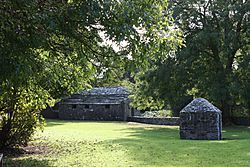Struell Wells facts for kids
Struell Wells (Irish: Toibreacha an tSruthail; Ulster-Scots: Struell Waals) are a group of four special holy wells. They are found in a place called Struell, about 2.4 kilometers (1.5 miles) east of Downpatrick in County Down, Northern Ireland.
These wells are very old, even older than Saint Patrick himself! People still visit them today, hoping to find cures for illnesses. Long ago, hundreds of pilgrims would come to Struell on special days like Mid-Summer Eve (also known as Saint John's Eve) and the Friday before Lammas.
The wells were first written about in 1306. However, the buildings you see there today were built later, around the 1600s. People have been making pilgrimages to this site for a very long time, from the 1500s all the way to the 1800s. Today, the Northern Ireland Environment Agency looks after the site.
Contents
What You Can See at Struell Wells
A fast-flowing stream runs through this quiet, rocky valley. Part of the stream even goes underground! The name of the site, Struell, comes from the Irish word sruthar or sruthail, which means stream.
There are five main buildings along the stream:
- The Old Church: Farthest to the north-west, you'll find the remains of a church from the mid-1700s. It seems it was never fully finished. This church likely replaced an even older one that was mentioned in records from 1306. Some pieces of stone windows from the 1200s were found here in 1957. You can now see them built into a nearby wall.
- The Drinking Well (Mother Well): This well is shaped like a beehive and has a rounded roof. It's located near the old church. People used to drink from this well.
- The Eye Well: This well is in the middle of the site. It's shaped like a rectangle and has a pyramid-shaped stone roof. People believed its water could help with eye problems.
- The Men's Bathing Well: This building has a stone roof. Inside, there's a changing room with seats. This leads to a bathing room with a sunken pool. Steps lead down into the pool, which fills with water from a stone channel. There used to be a way to control the water flow out of the bath.
- The Women's Bathing Well: Next to the Men's Bathing Well, this building also had a changing room with seats. The roof of this building is now gone. The water here came in from a higher spot, so women might have had water poured over them rather than taking a full bath. The water leaves through a drain in the wall.
Some smaller wells were used for washing specific body parts, like eyes, head, or arms and legs. Sometimes, a "Foot Well" was also mentioned. In the bigger wells, people would bathe their whole body. The bath houses covering these wells are very old. They were repaired by a lady named Lady Betty Cromwell in the 1600s.
Struell Wells and Saint Patrick
People often connect Struell Wells with Saint Patrick. It's said that he came from nearby Saul to bathe in these waters. However, there isn't any old proof to show this link. Legend says that Saint Patrick blessed the wells. It's also told that he spent many nights standing in the water, singing religious songs. These wells are probably the "fountain Slan" mentioned in a hymn about Saint Patrick by Saint Fiacc.
Pilgrims also came to the site to do penance, which means showing they were sorry for their mistakes. There is a special stone called the Chair of Saint Patrick (or Bed of Saint Patrick). It sits on top of a hill overlooking the wells. Near this stone chair is a rough circle of sharp stones called the Penitential Ring.
Long ago, there was a special ritual for pilgrims. It involved walking around all the wells and stone piles. The ritual ended by circling the Penitential Ring seven times on their knees, sometimes even carrying a large stone. After this, the person would sit on the Chair of Saint Patrick and turn themselves three times, always from left to right. Then, they would pray at an altar near the old chapel and finish by bathing in the wells.
History of the Wells
Struell Wells has been a popular place for pilgrimages since the Middle Ages. Someone important from the Pope's office might have visited the site in 1517. In 1643, a priest named Father Edmund McCana wrote that Saint Patrick's prayers had created the stream. Walter Harris wrote about the pilgrimage activities at the wells in 1744.
Pilgrimages continued into the 1800s. However, some noisy problems led to church leaders stopping the religious activities there. Because of this, fewer people visited the site.
In 2006, officials were asked why the wells were drying up and why two of them no longer had water. They said they knew about the water problems and were working to fix them, which included digging up some of the pipes.
Gallery








